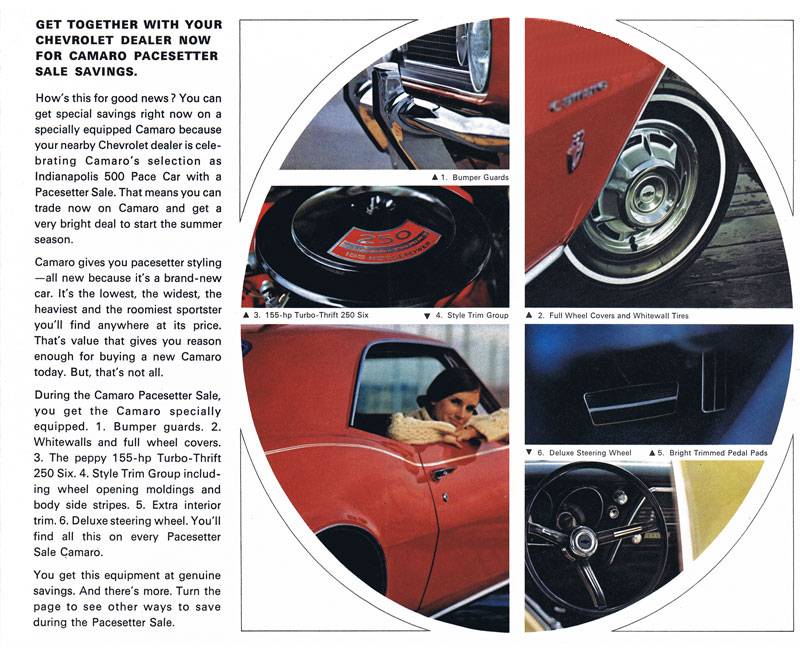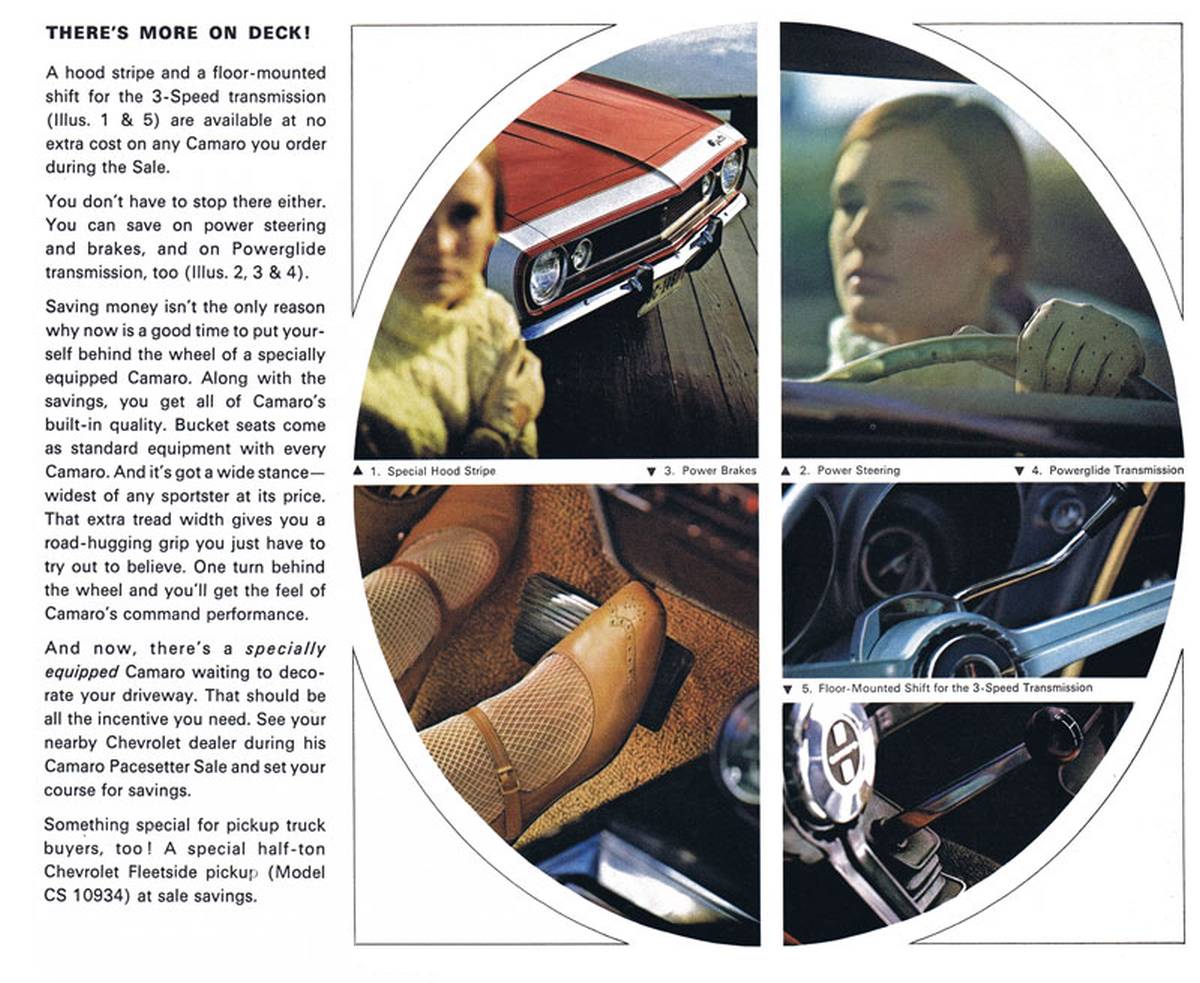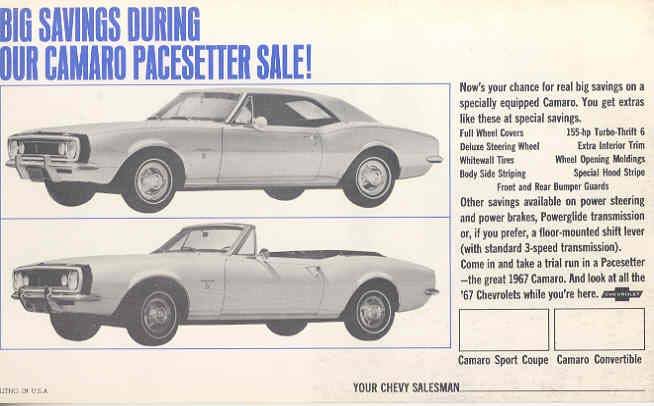
|

|

|
| C R G | CRG Reports | Exterior | Engine | 1967 Model ID |
| Numbers Decode | General Info | Interior | Transmission | 1968 Model ID |
| Drivetrain Decode | Options | Underhood | Chassis | 1969 Model ID |
©1998-2025, Camaro Research Group
Edited by Kurt Sonen and Rich Fields
Version: Thursday, 20-Feb-2025 17:13:56 EST
The Camaro was General Motors' pony car answer to the Ford Mustang. The F-body platform was shared with the Pontiac Firebird and was designed as a relatively light 4-passenger car. To make the weight and stiffness targets, the car used an innovative subframe under the front part of the car with unitized construction for the rear part of the car (as opposed to a full-frame or all unitized construction). Powertrain options ranged from L6 engines to small and big block V8 engines.
First-generation Camaros had two doors with 2+2 style seating (though a 5th set of belts was included in 68 & 69) and came in two basic models, coupe and convertible. They were built from the 1967 model year to the 1969 model year. Annual production ranged from about 220,000 to 240,000 cars.
About 75% of 1967-1969 Camaros were built at the Norwood, Ohio factory (near Cincinnati). Norwood built units for central and eastern US, as well as most export vehicles. (Assembled export units were rail-shipped to Baltimore, prepped for export (wax and oil spray, etc.), and loaded on ships.) The other major US assembly facility (~25% of the Camaro total) for Camaro was the Van Nuys, California assembly plant near Los Angeles. This was the primary assembly plant for units intended for western US delivery.
The GM assembly process is explained in detail in John's Camaro Assembly Process article.
In addition to the US assembly plants, many hundreds (if not several thousands) of Camaros were assembled at five overseas factories: the Yutivo factory in the Philippines (the subject of a CRG research article), GM Continental in Belgium, GM Suisse in Bienne, Switzerland, and two lesser-known assembly plants in Caracas, Venezuela and Lima, Peru. These non-US plants are the subject of the foreign assembly plant research article.
All of the non-U.S. factories assembled Camaros from "completely knocked down" (CKD) kits. The parts and subassemblies for CKD export units were exported as a kit with complete assembly required. The kits included the same parts and subassemblies that were delivered to the NOR and LOS assembly plants. The foreign plants had fixtures to weld the separate sheet metal stampings into assembled bodies, and attached the subassemblies (steering columns, transmissions, etc.) and various parts to build the finished car. Logistically, the parts for CKD export units were shipped to a collection point in Bloomfield, NJ, consolidated into kits, then packed six CKD kits per container for shipment overseas.
The automotive industry typically uses a model year that is offset from the calendar year. Sales dates for a car model typically start in September of the prior year and end the following August. Production start/stop dates are generally a month before the sales start/stop dates. For instance, the 1967 Camaro was built from August of 1966 through July of 1967. If a 1967 Camaro has a cowl tag date of 12A (indicating that the build month and week were the first week of December), then the car was built in December of 1966 (not December of 1967). A production gap of a couple of weeks between the end of one model year and the start of the next was common, and used for plant changeover for the next model year.
There are exceptions to this and the extended model year for the 1969 Camaro is one. The model year end for the 1969 Camaro was changed from July 1969 to November 1969, because the 1970 Camaro was not ready for release.
The extended '69 production and the delay of introduction of the '70 Camaro was not purposeful, nor was it related to labor problems; it was late because the quarter panel draw dies failed during final die tryout and had to be rebuilt from scratch. Fisher Body had lots of troubles drawing the 1970 quarter panels without wrinkles and splits. They attempted to correct the problems by modifying the draw dies during final tryout but the problems got worse instead of better. Fisher finally had to redesign/rebuild the draw dies, which delayed the launch by 4-5 months.
Chevrolet decided to extend the 1969 model, which created a wild scramble, as this meant extending part supplier contracts for the '69 (suppliers had already committed their facilities to other business), finding alternate capacity for '69 parts, etc. The PR department attempted to spin the delay in a different direction for public consumption as GM never publicly admitted any internal problems or failures, especially within Fisher Body, its biggest manufacturing Division, with the biggest tooling budget. But the delay of the 1970 Camaro was a black eye for Fisher Body Die Engineering, as it was the first production launch delay that was ever laid at their feet.
Official Chevrolet production records show a total of:
220,906 Camaros built in 1967
235,147 Camaros built in 1968
243,085 Camaros built in 1969
Note that the 1969 model year was extended to November 1969, 4 months longer than
normal, due to production delays with the redesigned 1970 Camaro.
The list below is Chevrolet's documentation of the end-of-month VIN for the GM assembly plants. * Due to several limitations, the VINs in this list will not necessarily correlate exactly with either a specific calendar day or the build week on the cowl tag. The data for some months (especially May and June 68 at Norwood) deviate significantly from actual build dates, while other months correlate well.* We are unsure of the source of these deviations, but uncertainties include:
Despite these limitations, the list remains a useful guide for approximate confirmation of date as to when a given VIN was built.
Repeating: * The VINs in this list will not necessarily correlate exactly with either a specific calendar day or the build week on the cowl tag. The data for some months (especially May and June 68 at Norwood) deviate significantly from actual build dates, while other months correlate well.*
*see limitations of this data noted above
LOS Camaro NOR Camaro
Month End Month End Month
VIN Total VIN Total
------ -------------- ---------------
1967 Model
Sep-66 7L104208 4208 7N111323 11323
Oct-66 7L112733 8525 7N124052 12729
Nov-66 7L122251 9518 7N140230 16178
Dec-66 7L130165 7914 7N160043 19813
Jan-67 7L137621 7456 7N174339 14296
Feb-67 7L144322 6701 7N179242 4903
Mar-67 7L150507 6185 7N197221 17979
Apr-67 7L155897 5390 7N209658 12437
May-67 7L158904 3007 7N224672 15014
Jun-67 7L163266 4362 7N241701 17029
Jul-67 7L165008 1742 7N254698 12997
1967 65008 154698
1968 Model LOS NOR
Sep-67 8L304745 4745 8N319989 19989
Oct-67 8L309652 4907 8N337720 17731
Nov-67 8L315860 6208 8N352898 15178
Dec-67 8L321968 6108 8N368090 15192
Jan-68 8L328091 6123 8N381420 13330
Feb-68 8L331484 3393 8N392427 11007
Mar-68 8L335251 3767 8N407303 14876
Apr-68 8L338564 3313 8N425530 18227
May-68 8L342085 3521 *8N465482 39952
Jun-68 8L345432 3347 *8N482588 17106
Jul-68 8L349164 3732 8N484735 2147
1968 49164 184735
1969 Model LOS NOR
Sep-68 9L502310 2310 9N512133 12133
Oct-68 9L506631 4321 9N530337 18204
Nov-68 9L510583 3952 9N551862 21525
Dec-68 9L513816 3233 9N569987 18125
Jan-69 9L520247 6431 9N589720 19733
Feb-69 9L525388 5141 9N607164 17444
Mar-69 9L528108 2720 9N623587 16423
Apr-69 9L530155 2047 9N637106 13519
May-69 9L530155 0 9N650323 13217
Jun-69 9L531026 871 9N664008 13685
Jul-69 9L531163 137 9N669119 5111
Aug-69 0 0 9N678253 9134
Sep-69 0 0 9N692607 14354
Oct-69 0 0 9N707932 15325
Nov-69 0 0 9N711922 3990
1969 31163 211922
*see limitations of this data noted above
|
CRG has published a downloadable RPO spreadsheet in PDF format that documents the official Chevrolet tallies for each first-generation Camaro Regular Production Option (including the base configurations), based on Len Williamson's "Tailfins & Bowties" printing of official Chevrolet production records.
Chevrolet did not retain statistical records on option combinations. Which means it is impossible to know with certainty the exact production number of multi-option combinations, e.g. RS and convertibles.
However, using the Chevrolet single-option production data, simple
statistics allow the estimation of production quantities of
many option combinations. CRG will leave the math for you to do.
The higher the number of combined options in the calculation (and the
rarer the options), the less reliable the result.
Realize that options were not uniformly distributed - very few low-cost
L6 cars got power windows, whereas positraction was commonly optioned in
hi-performance cars and in cars in the snow-belt states (for winter traction).
Until recently, there was no factory data on the production volumes of exterior or interior colors. However, CRG has obtained a copy of the unpublished production numbers for both exterior and interior colors and has published the exterior color usage and the interior color usage.
GM retained limited information on individual 67-69 Camaros. The data consists
of the original dealer that the car was shipped to (which may be different than
the selling dealer due to dealer trades) and the production date.
NCRS has made the data from these Shipping Data Reports available via the
Chevy Muscle Docs
website for a nominal $50 fee. This can be valuable information about the
origins of your car. Note that data for 1969 Camaros with VIN's between 9N508855
and 9N587275 is missing.
If your vehicle was originally sold in Canada, you can request a vehicle report from Vintage Vehicle Services. Contact information is below. For a nominal fee (for 67-69 Camaros: $118.65 CDN as of Jan 2015), you will receive information from the original computerized records which includes a list of the options, date of shipment, and the Canadian dealer. They are also able to provide info on Canadian-built 1993-2002 Camaros, as well as other Canadian-built GM models, e.g. GTO's, 442's and Chevelles, regardless of where they were originally sold.
Vintage Vehicle ServicesLittle satisfaction for the first-gen Camaro owner, but for 1977 and later Chevrolets (fleet and exported vehicles excluded), Pontiacs since 1987, Buicks since 1982, Cadillacs since 1980, Oldsmobiles since 1977, and GMC since 1976, GM is able to provide original vehicle invoices. Contact General Motors Media Archive for more information.
The best recourse for owners of most Camaros is to become a detective with whatever evidence is at hand. The original selling dealer information (see above) can be valuable in directing your research efforts. Any paper documentation (records, titles, receipts, Protect-o-plate, etc.) can also be extremely valuable in this search. Your detective job has been made more difficult with the enacting of a US Federal privacy statute making it very difficult to conduct private title searches. But there are some options.
Run a title history in the last known state it was located in. You will have to fill out the correct form and it may take a while, but some states still provide a fair amount of data. Try Zabasearch or similar search engines to locate prior owners.
You can check to make sure the vehicle wasn't stolen via NICB's free VINCheck service.
The NICB insurance database was federalized and is now available at National Motor Vehicle Title Information System. Due to the privacy act, all names and addresses were removed from the title history. There's a list of approved vendors on the NMVTIS page offering reports from the NMVTIS database - the content will be the same but the reports will vary in appearance and readability.
Beside the Reports and other pages of information on this
website, there are some references that are recommended.
The GM Heritage Center has
downloadable information packages that includes detailed and generally accurate specifications of
that year Camaro and the options. (FWIW, some pages are missing and some non-GM info may be inclused.)
This, unfortunately, does not include option or
configuration information on your exact unit, but it is free and a great reference.
If you are restoring a Camaro, this package will not tell you everything you will need and want to know. There are a number of web sources (many shown on our CRG Links page) that can provide a great deal of further assistance.
Critical printed references that the CRG recommends that you investigate include the following GM manuals and other books:
There are also a number of other worthwhile publications.
If you do not currently have a Camaro and are considering a purchase, CRG suggests consideration of either or both of two light-duty books by Michael Antonick that give a good general overview of each year up to and including the modern era - however they are not definitive for research as they contain some errors (generally minor) and numerous omissions for the sake of brevity:
1967 mid-year changes included:
The Corvette only shared a limited number of colors with Camaro, and then only for a limited time. Starting in January 1968, LeMans Blue, Corvette Bronze, and British Green, all of which were Corvette colors, were introduced to Camaro. LeMans Blue continued on into the 1969 model year as a shared color between the two models. The other two colors were dropped from Camaro at the end of the 1968 model and no new shared colors were added.
The rear antenna option, U73, was not available from the factory with either of the AM/FM radios (U69/U79) or the D80 spoiler. However, the rear antenna could be installed by the dealer, even with these other options.
Unusual options with short lives, or those that were documented for production but that never made it into production, include:
Camaros were available with a wide range of options, some of which were obscure, or simply not well documented, which cause them to be quite rare. Some examples:
The 1967 Chevrolet Pacesetter promotion was intended to leverage the selection of the 1967 Camaro as the pace car for the 67 Indy 500. It was not performance oriented, but a sales promotion, mostly oriented toward L6 cars. The 4/10/67 initial announcement said "Chevrolet and its dealers are launching a nationwide Camaro Pacesetter sales campaign this month to mark the selection of the Camaro as pace car for this year's Indianapolis 500 race on Memorial Day." "During the Pacesetter event, Camaro buyers can get the special hood stripe and floor-mounted shift for three-speed transmission at no extra cost with special savings also available on Powerglide automatic transmission, power steering and power brakes."
|
|
|
The various Pacesetter ads and literature include some details of the sale, but some details were unclear or appear conflicted. The promotion focused on L6 cars. There was a notable surge in L6 orders after this promotion started, probably driven by profit potential for the dealers. The only V8 cars involved in the promotion were those ordered with the M11 floor shifter and/or the D91 nose stripe. Few V8 cars have been documented as part of the Pacesetter sale.
The specifics of the Pacesetter sale were:
Data on cars involved in the promotion is somewhat limited, but is sufficient to explain some to the details of the campaign. The first cars that had the promotion were built in mid-April and, although the campaign was supposed to run through June, it continued until the end of the model year. The window sticker showed the normal option list and prices. The GMAC invoice to the dealer showed a credit to the dealer for the promotion as a line item. How much of the savings the dealer passed on appears to be at the dealer’s discretion – there are some dealer invoices that show full price was charged to the customer without any discount.
|
|